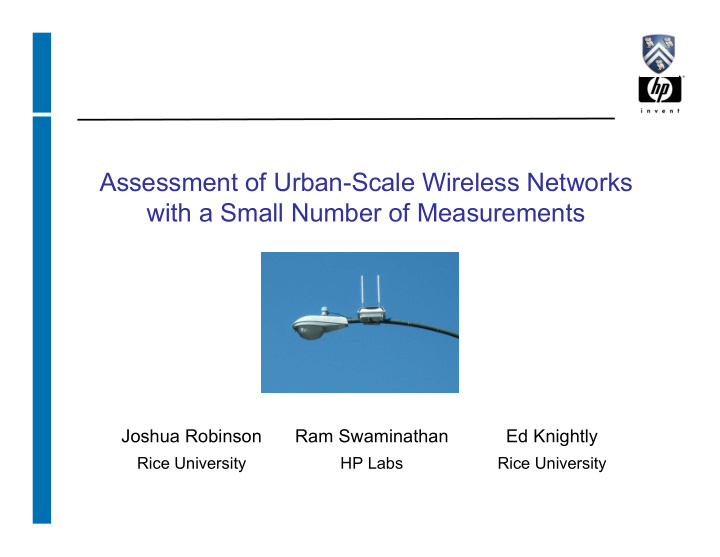



Assessment of Urban-Scale Wireless Networks with a Small Number of Measurements Joshua Robinson Ram Swaminathan Ed Knightly Rice University HP Labs Rice University
Urban Wireless Networks • Goal to provide wireless Internet coverage over large areas • Low cost by leveraging WiFi/mesh technology • Challenge: to achieve coverage and capacity subject to cost constraints • Industry example: – “But soon it became clear that dependable reception required more routers than initially predicted, which drastically raised the cost of building the networks.” New York Times. March 22, 2008.
Deployment Assessment Problem Mesh nodes Mesh node locations in GoogleWiFi network Challenge: Cannot determine actual network performance until network is deployed Objective: Identify whether each client location meets a performance threshold
Exhaustive Assessment Measure! ? Exhaustive measurement study is prohibitively expensive • Especially for staged assessment of newly deployed nodes Instead: Goal is to predict each location’s performance with limited measurement budget
Assessment and Estimation Metric region Output: mesh assessment • To predict, we estimate a mesh node's metric region : the set of all locations with measurements meeting a performance threshold • Related work: ray-tracing used to estimate physical-layer propagation, but high accuracy requires detailed environment info
Assessment Framework • Present and validate a framework to estimate metric regions through a small number of measurements: – Measurement process guided by physical-layer estimation and prior measurement results – Metric region estimation using coarse-grained terrain maps and the construction of per-node virtual sectors Estimated metric region Measurement refinement Estimation with terrain maps and sectors
Outline • Introduction • Framework: Estimation and refinement description • Validation: – Framework accuracy in real networks and error bounds • Application: – Coverage holes in existing deployments • Conclusion
Metric Sector Framework Challenge: Non-uniform propagation Framework approach: Divide metric region into virtual sectors • Estimate the metric boundary of each sector independently Example node metric region
Estimation of Metric Region Challenge: Highly variable interactions with terrain results in irregular region boundary Framework two-stage approach: 1. Predict propagation variations using terrain maps to estimate region boundaries 2. Measure to refine boundaries Positive variation Average path loss Negative curve variation
Estimation via Terrain Features Point 1 Dense apartment buildings --> negative variation Point 2 Line-of-sight down street --> positive variation • Estimate metric region boundary using map information – Use coarse-grain terrain features to predict variations per link – Predicted variation is sum of cumulative impact of each intervening terrain feature – Requires training measurements to understand impact of different features
Estimating Sector Boundary Metric Sector Estimated boundary • Limit measurements by refining boundary on per sector basis – Number of sectors chosen based on measurement budget – Key technique to use estimations to choose sector widths with uniform boundary
Refining Boundary Estimates Refined boundary Estimated boundary • Design simple push/pull heuristic to move each boundary closer/farther from mesh node – Measurement locations guided by estimations and previous measurement results – Little state kept to recover from noisy measurements
Validation on Deployed Networks • Approximately 30,000 measured locations in the TFA and GoogleWiFi networks • Laptop with external antenna • Different antennas, tree cover, terrain, and target area size • Evaluate predictive accuracy of our framework with small subset of measurements
Results: Monotonicity Property Violation! Measure on ray • Monotonicity property: – For any ray from a mesh node, metric M is non-increasing with distance • Allows modeling metric region as a connected region • Consider metrics that (mostly) satisfy – Coverage (SNR) and metrics based on coverage
Coverage Monotonicity Fig. Per-sector accuracy error due to Fig. Probability of violation monotonicity violations • Monotonicity violations due to multi-path – GoogleWiFi features stronger line-of-sight links • Result in average error per sector of 10% for GoogleWiFi and 15% for TFA • Results show that estimation and refinement achieve within 3% of upper bound
Application: Coverage Holes • Coverage hole is a location outside of any coverage region • As function of effective deployment density at Holes client locations • TFA and GoogleWiFi use different hardware, so same probabilities are not expected
Examining Coverage Holes • GoogleWiFi hole probability has much weaker dependence on deployment density • Holes likely to be in sector with worse-than-average propagation • Indicates small “trouble” spots where increasing node density does not help • Client-side solutions may be most cost-effective
Assessment Contributions • Show accurate estimation by coupling terrain maps, per- node virtual sectorization, and measurement refinement • Show that despite violations of the monotonicity property, framework attains high accuracy on real deployments • In existing deployments, apply framework to study coverage holes and load balancing – Key challenge: large number of additional nodes needed to eliminate numerous small coverage holes http://tfa.rice.edu/ -- TFA background/info http://tfa.rice.edu/measurements/ -- measurement data http://networks.rice.edu
Recommend
More recommend